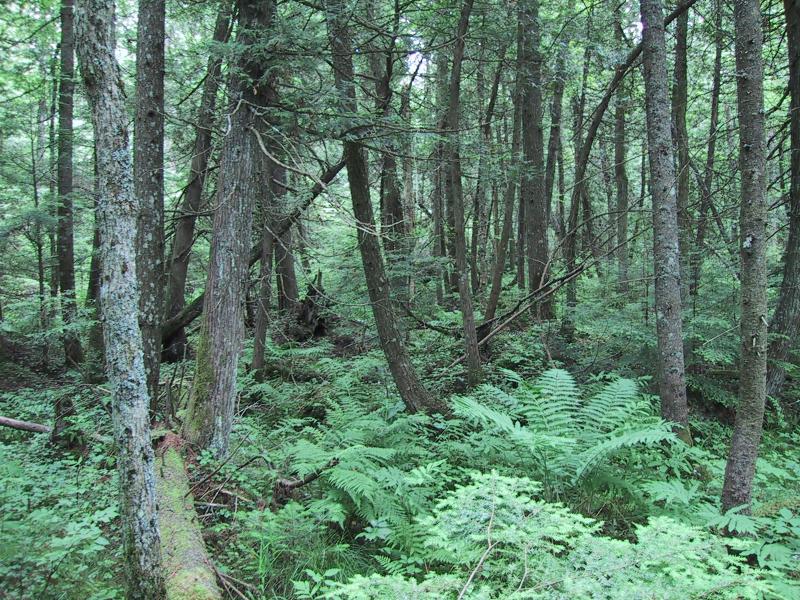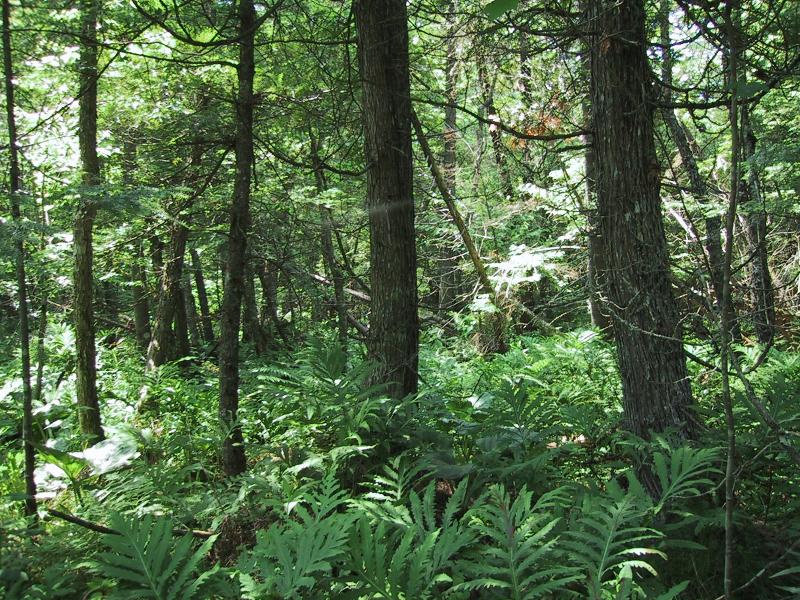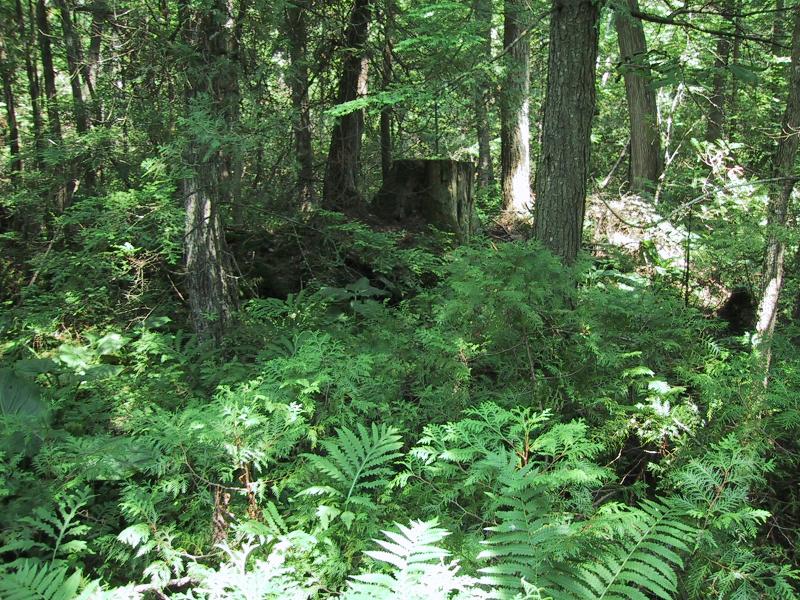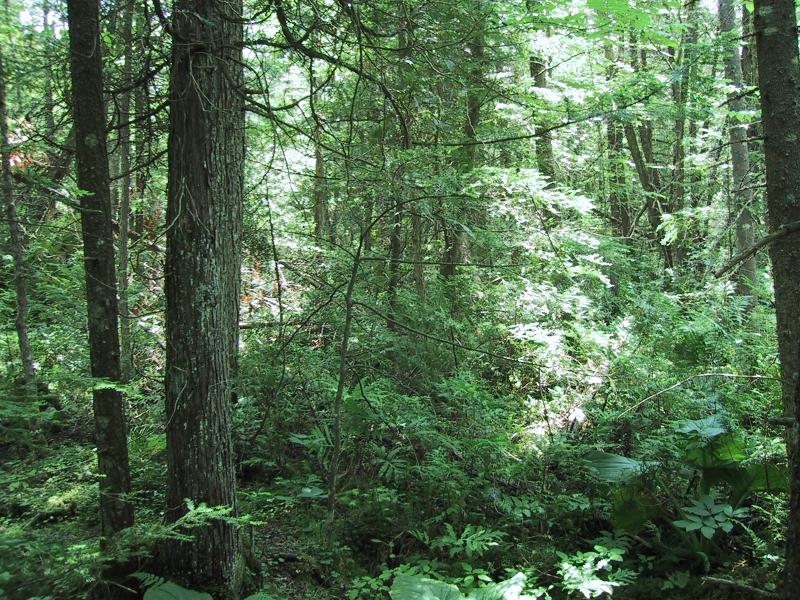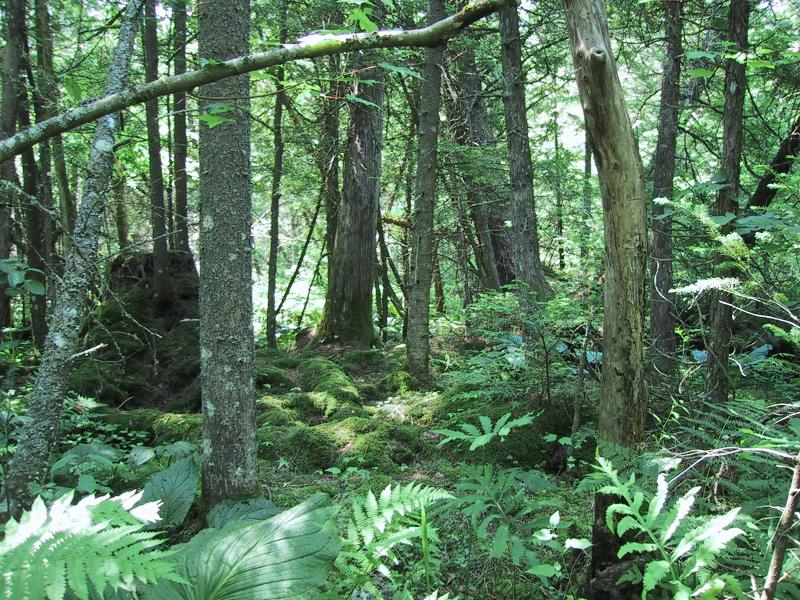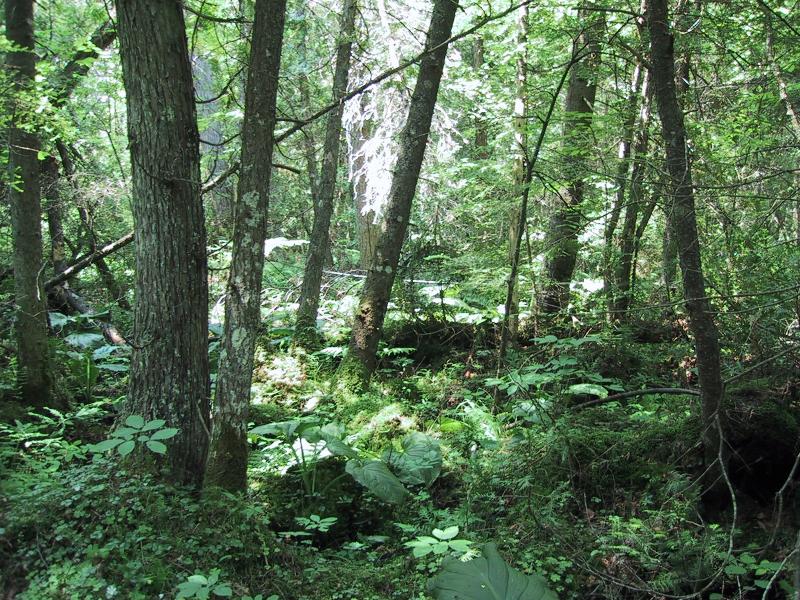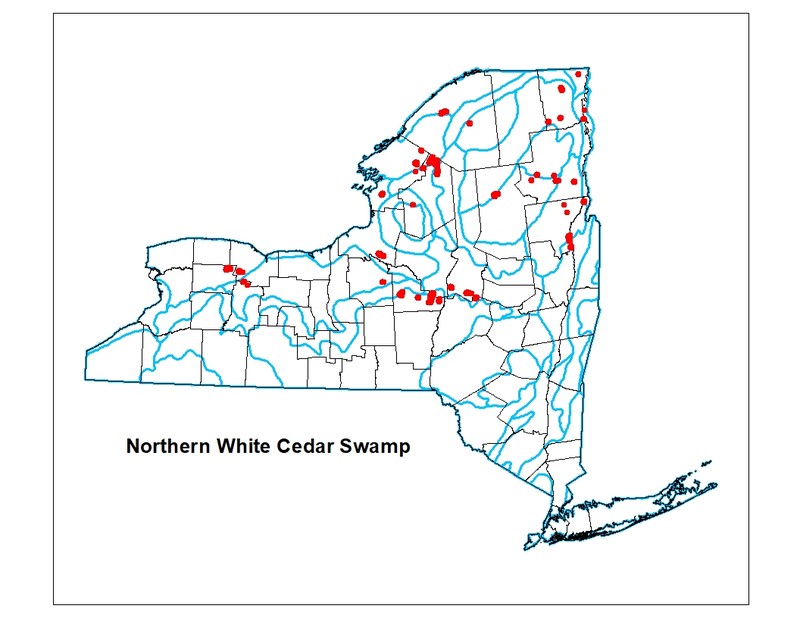Northern White Cedar Swamp
- System
- Palustrine
- Subsystem
- Forested Peatlands
- State Protection
- Not Listed
Not listed or protected by New York State.
- Federal Protection
- Not Listed
- State Conservation Status Rank
- S2S3
Imperiled or Vulnerable in New York - Very vulnerable, or vulnerable, to disappearing from New York, due to rarity or other factors; typically 6 to 80 populations or locations in New York, few individuals, restricted range, few remaining acres (or miles of stream), and/or recent and widespread declines. More information is needed to assign either S2 or S3.
- Global Conservation Status Rank
- G4
Apparently Secure globally - Uncommon in the world but not rare; usually widespread, but may be rare in some parts of its range; possibly some cause for long-term concern due to declines or other factors.
Summary
Did you know?
White-tailed deer spend much of their time during the winter months in northern white cedar swamps, munching on their favorite winter food. Northern white cedar is not regenerating well in some of these swamps due to this over browsing.
State Ranking Justification
There are several hundred occurrences statewide. Some documented occurrences have good viability and many are protected on public land or private conservation land. This community is scattered and essentially limited to the northern half of the state, and includes several large, high quality examples. The current trend of this community is probably stable for occurrences on public land, or declining slightly elsewhere due to moderate threats that include alteration of the natural hydrology (primarily by beaver) and invasive species.
Short-term Trends
The number and acreage of northern white cedar swamps in New York have probably declined slightly, or remained stable, in recent decades as a result of wetland protection regulations. A few examples may have declined due to flooding by beaver.
Long-term Trends
The number and acreage of northern white cedar swamps in New York have probably declined substantially from historical numbers likely correlated with agricultural and development.
Conservation and Management
Threats
Northern white cedar swamps are threatened by development (e.g., agriculture, residential, roads, railroads), habitat alteration (e.g., excessive logging, sediment/pollution run-off, plantations, trash dumping), and recreational overuse (e.g., hiking trails, horse trails, ATVs, campgrounds). Alteration to the natural hydrological regime is also a threat to this community (e.g., impoundments, blocked culverts, beaver). Several northern white cedar swamps are threatened by invasive species, such as Berberis thunbergii, Frangula alnus, Solanum dulcamara, Tussilago farfara, and Rhamnus cathartica. Timber harvest is a threat at some sites, because white cedar is naturally resistant to rot. It has been used for shingles and posts, and is a valuable tree for wood products (Sorenson et al. 1998), thus making this community an important source for this tree. Northern white cedar swamps that have black ash (Fraxinus nigra) may be threatened by emerald ash borer. The emerald ash borer (Agrilus planipennis) is an Asian beetle that infests and kills North American ash trees. All native ash trees are susceptible, including white ash, green ash, and black ash. In New York, emerald ash borer has been found mostly south of the Adirondack Mountains, but in 2017 it was recorded in Franklin and St. Lawrence Counties. Natural communities dominated or co-dominated by ash trees, such as black ash in northern white cedar swamps for example, would likely be most impacted by emerald ash borer invasion.
Conservation Strategies and Management Practices
Where practical, establish and maintain a natural wetland buffer to reduce storm-water, pollution, and nutrient run-off, while simultaneously capturing sediments before they reach the wetland. Buffer width should take into account the erodibility of the surrounding soils, slope steepness, and current land use. Wetlands protected under Article 24 are known as New York State "regulated" wetlands. The regulated area includes the wetlands themselves, as well as a protective buffer or "adjacent area" extending 100 feet landward of the wetland boundary (NYS DEC 1995). If possible, minimize the number and size of impervious surfaces in the surrounding landscape. Avoid habitat alteration within the wetland and surrounding landscape. For example, roads and trails should be routed around wetlands, and ideally not pass through the buffer area. If the wetland must be crossed, then bridges and boardwalks are preferred over filling. Restore past impacts, such as removing obsolete impoundments and ditches in order to restore the natural hydrology. Prevent the spread of invasive exotic species into the wetland through appropriate direct management, and by minimizing potential dispersal corridors, such as roads.
Development and Mitigation Considerations
When considering road construction and other development activities minimize actions that will change what water carries and how water travels to this community, both on the surface and underground. Water traveling over-the-ground as run-off usually carries an abundance of silt, clay, and other particulates during (and often after) a construction project. While still suspended in the water, these particulates make it difficult for aquatic animals to find food; after settling to the bottom of the wetland, these particulates bury small plants and animals and alter the natural functions of the community in many other ways. Thus, road construction and development activities near this community type should strive to minimize particulate-laden run-off into this community. Water traveling on the ground or seeping through the ground also carries dissolved minerals and chemicals. Road salt, for example, is becoming an increasing problem both to natural communities and as a contaminant in household wells. Fertilizers, detergents, and other chemicals that increase the nutrient levels in wetlands cause algae blooms and eventually an oxygen-depleted environment where few animals can live. Herbicides and pesticides often travel far from where they are applied and have lasting effects on the quality of the natural community. So, road construction and other development activities should strive to consider: 1. how water moves through the ground, 2. the types of dissolved substances these development activities may release, and 3. how to minimize the potential for these dissolved substances to reach this natural community.
Inventory Needs
Survey for occurrences statewide to advance documentation and classification of northern white cedar swamps. A statewide review of northern white cedar swamps is desirable, similar to the studies done in New Hampshire (Sperduto and Engstom 1998) and Vermont (Sorenson et al. 1998). Continue searching for large sites in good condition especially those over 100 acres.
Research Needs
Research composition of northern white cedar swamps statewide in order to characterize variations reported in nearby states (Sorenson et al. 1998, Sperduto and Engstrom 1998). Collect sufficient plot data to support the recognition of several distinct northern white cedar swamp types based on composition and by ecoregion.
Rare Species
- Arethusa bulbosa (Dragon's Mouth Orchid) (guide)
- Bartonia paniculata ssp. paniculata (Green Screwstem) (guide)
- Betula pumila (Swamp Birch) (guide)
- Calypso bulbosa var. americana (Calypso) (guide)
- Carex arcta (Northern Clustered Sedge) (guide)
- Carex gynocrates (Northern Bog Sedge) (guide)
- Carex livida (Livid Sedge) (guide)
- Carex sartwellii (Sartwell's Sedge) (guide)
- Carex schweinitzii (Schweinitz's Sedge) (guide)
- Carex sychnocephala (Many-headed Sedge) (guide)
- Carex tenuiflora (Sparse-flowered Sedge) (guide)
- Carex vaginata (Sheathed Sedge) (guide)
- Corallorhiza striata var. striata (Striped Coralroot) (guide)
- Cypripedium arietinum (Ram's Head Lady's Slipper) (guide)
- Emydoidea blandingii (Blanding's Turtle) (guide)
- Macropis nuda (Common Loosestrife Oil Bee) (guide)
- Neottia auriculata (Auricled Twayblade) (guide)
- Neottia convallarioides (Broad-lipped Twayblade) (guide)
- Pyrola asarifolia ssp. asarifolia (Pink Shinleaf) (guide)
- Rorippa aquatica (Lake Water Cress) (guide)
- Solidago ohioensis (Ohio Goldenrod) (guide)
- Sparganium natans (Small Bur-reed) (guide)
- Symphyotrichum boreale (Northern Bog Aster) (guide)
- Trollius laxus (Spreading Globeflower) (guide)
- Valeriana uliginosa (Marsh Valerian) (guide)
Range
New York State Distribution
This community is scattered and essentially limited to the northern half of the state. It is concentrated in the Great Lakes Ecoregion, but also common in the Adirondack Subsection of the Northern Appalachian Ecoregion where it is represented by large patch occurrences. There are scattered very small patch examples at the northern fringe of the Lower New England Ecoregion, Tug Hill Subsection of the Northern Appalachian Ecoregion, and the High Allegheny Plateau Ecoregion.
Global Distribution
The range of this community is probably limited to the Northeast United States and Great Lakes basins, and southeastern Canada. The range is estimated to span north to central Ontario and Quebec, west to Minnesota, south to the Southern Tier of New York, and east to New Brunswick.
Best Places to See
- Adirondack Park (Warren County)
- Bergen Swamp Preserve
- Silver Lake Camp Preserve, Adirondack Park
- Sargent Ponds Wild Forest, Adirondack Park (Hamilton County)
- Silver Lake Bog Preserve
- Bonaparte Swamp Preserve (Lewis County)
- White Lake Swamp Preserve (Onondaga County)
- Black Creek Park (Monroe County)
- Higley Flow State Park (St. Lawrence County)
- Fiddlers Green Preserve (Madison County)
Identification Comments
General Description
A rich conifer or mixed swamp that occurs on organic soils in cool, poorly drained depressions in central and northern New York and along lakes and streams in the northern half of the state. These swamps are often spring fed or enriched by seepage of cold, minerotrophic groundwater, resulting in a stable water table and continually saturated soils. The characteristic tree is northern white cedar (Thuja occidentalis), which makes up more than 30% of the canopy cover; characteristic short shrubs include dwarf raspberry and red osier dogwood. The surface of the peatland typically has small mounds and depressions called hummocks and hollows that are formed by decaying downed trees and tip-up mounds. Mosses and liverworts are diverse and abundant.
Characters Most Useful for Identification
A forested peatland that is characterized by northern white cedar, which makes up 30% or more of the tree canopy and tall shrub cover.
Elevation Range
Known examples of this community have been found at elevations between 100 feet and 1,909 feet.
Best Time to See
Northern white cedar, hemlock, balsam fir, and red maple are often found in a northern white cedar swamp; the striking contrast between the evergreens and the red maple's seasonal color can be enjoyed in the fall. The community also contains a number of herbaceous species that bloom in the spring (starflower, bunchberry, Canada mayflower, and blue bead lily) as well as a diverse assortment of mosses and liverworts that are beautiful year-round.
Northern White Cedar Swamp Images
Classification
International Vegetation Classification Associations
This New York natural community encompasses all or part of the concept of the following International Vegetation Classification (IVC) natural community associations. These are often described at finer resolution than New York's natural communities. The IVC is developed and maintained by NatureServe.
- Northern White-cedar - Red Maple / Red-osier Dogwood Swamp Forest (CEGL006199)
- Northern White-cedar - (Red Spruce) / Heartleaf Foamflower Swamp Forest (CEGL006175)
- Northern White-cedar / (Girgensohn's Peatmoss, Fen Peatmoss) Swamp Forest (CEGL006007)
NatureServe Ecological Systems
This New York natural community falls into the following ecological system(s). Ecological systems are often described at a coarser resolution than New York's natural communities and tend to represent clusters of associations found in similar environments. The ecological systems project is developed and maintained by NatureServe.
- Acadian-Northern Appalachian Conifer Seepage Forest (CES201.576)
- Laurentian-Acadian Alkaline Conifer-Hardwood Swamp (CES201.575)
Characteristic Species
-
Trees > 5m
- Abies balsamea (balsam fir)
- Acer rubrum var. rubrum (common red maple)
- Betula alleghaniensis (yellow birch)
- Fraxinus nigra (black ash)
- Larix laricina (tamarack)
- Picea mariana (black spruce)
- Pinus strobus (white pine)
- Thuja occidentalis (northern white cedar, arbor vitae)
- Tsuga canadensis (eastern hemlock)
-
Shrubs 2 - 5m
- Alnus incana ssp. rugosa (speckled alder)
- Cornus sericea (red-osier dogwood)
- Nemopanthus mucronatus
-
Shrubs < 2m
- Rubus pubescens (dwarf raspberry)
-
Herbs
- Aralia nudicaulis (wild sarsaparilla)
- Caltha palustris (marsh-marigold)
- Carex leptalea (bristle-stalked sedge)
- Carex trisperma (three-fruited sedge)
- Clintonia borealis (blue bead-lily)
- Coptis trifolia (gold-thread)
- Cornus canadensis (bunchberry)
- Glyceria striata (fowl manna grass)
- Gymnocarpium dryopteris (oak fern)
- Impatiens capensis (spotted jewelweed, spotted touch-me-not)
- Lysimachia borealis (starflower)
- Mitella nuda (naked mitrewort, naked bishop's-cap)
- Onoclea sensibilis (sensitive fern)
- Osmundastrum cinnamomeum var. cinnamomeum (cinnamon fern)
- Thelypteris palustris var. pubescens (marsh fern)
-
Nonvascular plants
- Bazzania trilobata
- Hylocomium splendens
- Ptilium crista-castrensis
- Sphagnum spp.
- Trichocolea tomentella
Similar Ecological Communities
- Black spruce-tamarack bog
(guide)
Black spruce-tamarack bog peatlands are more acidic than northern white cedar swamps. They are distinguished by having a combined tree and tall shrub cover of tamarack and black spruce that is greater than that of northern white cedar and black ash.
- Red maple-hardwood swamp
(guide)
Red maple-hardwood swamps are found on flooded muck soils; they are distinguished by having a combined cover of red maple and black ash in the tree and possibly tall shrub layers that is greater than that of northern white cedar.
- Rich graminoid fen
(guide)
Tree cover in northern white cedar swamps should ideally be greater than 60%, but must be greater than 50%. Examples with more open canopies could grade into rich graminoid fens, which are also mineral-rich peatlands but are dominated by sedges.
- Rich shrub fen
(guide)
Tree cover in northern white cedar swamps should ideally be greater than 60%, but must be greater than 50%. Examples with more open canopies could grade into rich shrub fens, which are also mineral-rich peatlands but are dominated by shrubs such as shrubby cinquefoil, red osier dogwood, and speckled alder.
- Spruce-fir swamp
(guide)
Spruce-fir swamps are distinguished from northern white cedar swamps by having predominately mineral soils and a combined tree and tall shrub cover of balsam fir and red spruce that is greater than that of northern white cedar and black ash.
Vegetation
Percent cover
This figure helps visualize the structure and "look" or "feel" of a typical Northern White Cedar Swamp. Each bar represents the amount of "coverage" for all the species growing at that height. Because layers overlap (shrubs may grow under trees, for example), the shaded regions can add up to more than 100%.
Additional Resources
References
Anderson, K.L. and D.J. Leopold. 2002. The role of canopy gaps in maintaining vascular plant diversity at a forested wetland in New York State. Journal of the Torrey Botanical Society 129(3), 238-250.
Cowardin, L.M., V. Carter, F.C. Golet, and E.T. La Roe. 1979. Classification of wetlands and deepwater habitats of the United States. U.S. Fish and Wildlife Service. Washington, D.C. 131 pp.
Curtis, J.D. 1946. Preliminary observations on northern white cedar in Maine. Ecology 27(1):23-36.
Edinger, G. J., D. J. Evans, S. Gebauer, T. G. Howard, D. M. Hunt, and A. M. Olivero (editors). 2014. Ecological Communities of New York State. Second Edition. A revised and expanded edition of Carol Reschke’s Ecological Communities of New York State. New York Natural Heritage Program, New York State Department of Environmental Conservation, Albany, NY. https://www.nynhp.org/ecological-communities/
Edinger, Gregory J., D.J. Evans, Shane Gebauer, Timothy G. Howard, David M. Hunt, and Adele M. Olivero (editors). 2002. Ecological Communities of New York State. Second Edition. A revised and expanded edition of Carol Reschke's Ecological Communities of New York State. (Draft for review). New York Natural Heritage Program, New York State Department of Environmental Conservation. Albany, NY. 136 pp.
Langdon, Stephen F., M. Dovciak, and D.J. Leopold. 2020. Tree Encroachment Varies by Plant Community in a Large Boreal Peatland Complex in the Boreal-Temperate Ecotone of Northeastern USA. Wetlands. https://doi.org/10.1007/s13157-020-01319-z
New York Natural Heritage Program. 2024. New York Natural Heritage Program Databases. Albany, NY.
New York Natural Heritage Program. No date. Field forms database: Electronic field data storage and access for New York Heritage ecology, botany, and zoology. New York Natural Heritage Program, New York State Department of Environmental Conservation. Albany, NY.
New York State Department of Environmental Conservation. 1995. Freshwater Wetlands: Delineation Manual. July 1995. New York State Department of Environmental Conservation. Division of Fish, Wildlife, and Marine Resources. Bureau of Habitat. Albany, NY.
Reschke, Carol. 1990. Ecological communities of New York State. New York Natural Heritage Program, New York State Department of Environmental Conservation. Latham, NY. 96 pp. plus xi.
Seischab, F.K. 1984. Plant community development in the Byron-Bergen Swamp: Marl bed vegetation. Can. J. Bot. 62:1006-1017.
Shanks, R.E. 1966. An ecological survey of the vegetation of Monroe County, New York. Proc. Rochester Academy Sci. 11:108-252.
Sorenson, E., B. Engstrom, M. Lapin, R. Popp, and S. Parren. 1998. Northern white cedar swamps and red maple-northern white cedar swamps of Vermont: some sites of ecological significance. Vermont Nongame and Natural Heritage Program, Waterbury, Vermont.
Sperduto, D.D. and B. Engstrom. 1998. Northern white cedar swamps of New Hampshire. New Hampshire Natural Heritage Inventory, Concord, N.H.
Links
About This Guide
This guide was authored by: Aissa Feldmann
Information for this guide was last updated on: March 26, 2024
Please cite this page as:
New York Natural Heritage Program. 2024.
Online Conservation Guide for
Northern white cedar swamp.
Available from: https://guides.nynhp.org/northern-white-cedar-swamp/.
Accessed July 27, 2024.

